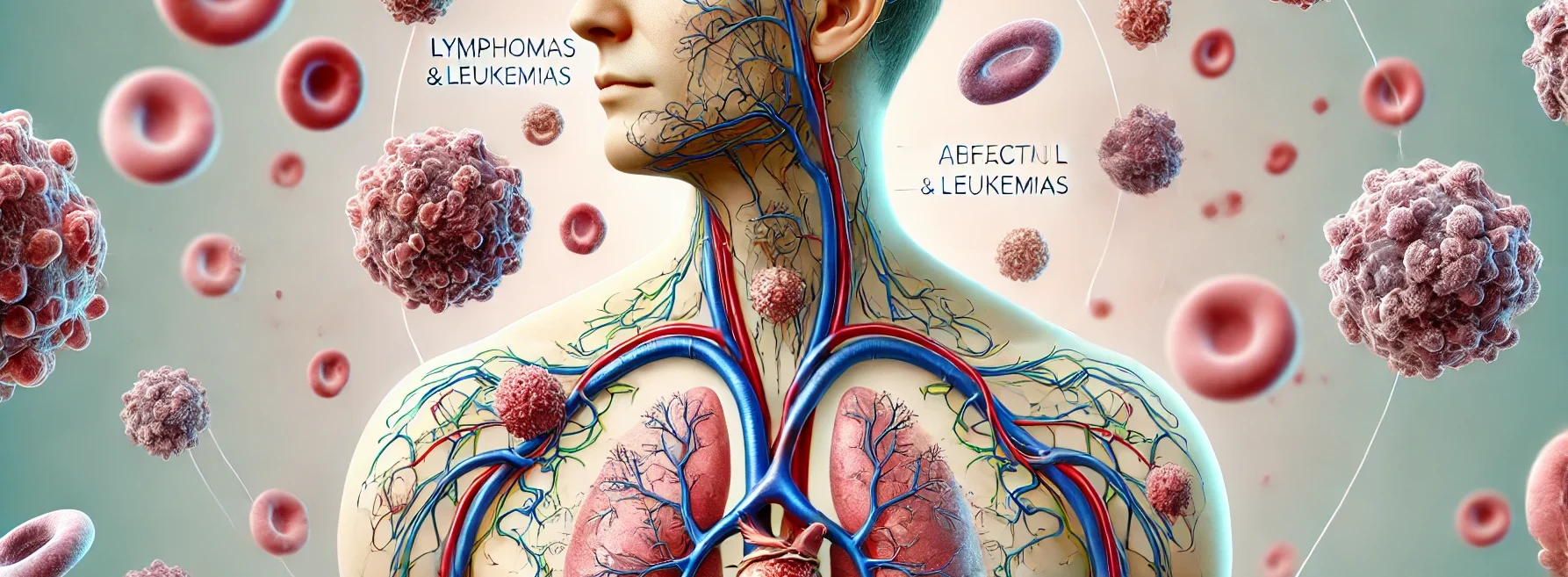Lymphomas and leukemias are types of cancers that affect the body’s immune and blood systems. These cancers disrupt normal blood cell production and weaken the immune system, making early detection and treatment essential for improving patient outcomes. Understanding their causes, symptoms, and available treatment options can help individuals recognize warning signs and seek medical attention promptly.
What are Lymphomas and Leukemias?
Lymphomas and leukemias are both blood-related cancers, but they affect different parts of the body:
- Lymphomas develop in the lymphatic system, which is responsible for maintaining immune function. They specifically target lymphocytes, a type of white blood cell that helps fight infections.
- Leukemia is a cancer of the blood and bone marrow, where blood cells are produced. It affects the body’s ability to generate healthy blood cells, leading to various complications.
Understanding Lymphomas and Leukemias
Both cancers impair the immune system’s function and disrupt the normal production of blood cells.
- Lymphoma: Affects lymphocytes and can develop in lymph nodes, the spleen, or other lymphoid tissues.
- Leukemia: Affects the bone marrow, leading to an overproduction of abnormal white blood cells that crowd out healthy cells.
These conditions can develop due to various genetic and environmental factors, and their progression varies based on type and stage.
Causes of Lymphomas and Leukemias
Although the exact cause of these cancers remains unknown, several risk factors increase the likelihood of developing lymphoma or leukemia:
1. Genetic Mutations
Mutations in certain genes can trigger uncontrolled cell growth, leading to cancer formation. Some genetic conditions may also predispose individuals to these cancers.
2. Viral Infections
Some viruses have been linked to these cancers, including:
- Epstein-Barr Virus (EBV): Associated with Hodgkin lymphoma and some non-Hodgkin lymphomas.
- Human T-cell Leukemia Virus (HTLV-1): Linked to certain types of leukemia.
3. Radiation Exposure
Long-term exposure to high levels of radiation, such as in radiation therapy or nuclear accidents, can increase the risk of developing leukemia and lymphoma.
4. Immune System Disorders
People with weakened immune systems, including those with autoimmune diseases or who have undergone organ transplants, have a higher risk of developing these cancers.
Symptoms of Lymphomas and Leukemias
The symptoms of lymphomas and leukemias often overlap and can be mistaken for common illnesses. However, persistent or worsening symptoms should not be ignored.
Common Symptoms Include:
- Swollen lymph nodes (in the neck, armpits, or groin)
- Frequent infections due to weakened immunity
- Easy bruising or bleeding (including nosebleeds or excessive bleeding from small cuts)
- Persistent fatigue that does not improve with rest
- Unexplained weight loss and loss of appetite
- Night sweats and fever
- Bone pain or tenderness (more common in leukemia)
- Shortness of breath or anemia (low red blood cell count)
If these symptoms persist for more than a few weeks, consulting a medical specialist is recommended.
Screening and Diagnosis
Early diagnosis is key to effective treatment. Several diagnostic tests help confirm the presence of lymphoma or leukemia:
1. Blood Tests
Routine blood tests, such as a complete blood count (CBC), help detect abnormal blood cell counts and provide insight into potential leukemia.
2. Bone Marrow Biopsy
A sample of bone marrow is extracted and examined under a microscope to confirm leukemia and determine its type.
3. Lymph Node Biopsy
A small sample of a swollen lymph node is removed and analyzed to diagnose lymphoma.
4. Imaging Tests
- CT scans and PET scans: Identify the spread and severity of lymphoma.
- MRI scans: May be used to detect cancer in the brain or spinal cord.
Treatment Stages of Lymphomas and Leukemias
The treatment approach depends on the cancer type, stage, and overall patient health. Treatment options include:
Early-Stage Treatment
- Chemotherapy: The primary treatment for most lymphomas and leukemias, using drugs to kill cancer cells.
- Radiation Therapy: Uses high-energy radiation to shrink tumors and eliminate cancer cells.
Intermediate-Stage Treatment
- Targeted Therapies: These treatments target specific cancer cells without harming normal cells. Examples include monoclonal antibodies and kinase inhibitors.
Advanced-Stage Treatment
- Stem Cell Transplants: Replace damaged bone marrow with healthy stem cells to regenerate normal blood cell production.
- Immunotherapy: Boosts the body’s immune system to fight cancer cells effectively.
- CAR-T Cell Therapy: A specialized form of immunotherapy that reprograms a patient’s T-cells to target cancer cells.
When to Consult a Specialist?
Early detection significantly improves treatment outcomes. Consult a doctor if you experience:
- Unexplained persistent fatigue that affects daily life.
- Frequent infections or excessive bruising without clear cause.
- Swollen lymph nodes that do not resolve over time.
- Prolonged fever or night sweats.
A hematologist-oncologist specializes in diagnosing and treating blood-related cancers and can recommend the best course of action.
Frequently Asked Questions (FAQs)
1. Are lymphomas and leukemias curable?
Many types of lymphoma and leukemia can be successfully treated, especially when diagnosed early. Treatment advancements have significantly improved survival rates and quality of life.
2. What are the survival rates?
Survival rates vary based on cancer type and stage at diagnosis. Certain types of leukemia and lymphoma, such as Hodgkin lymphoma and acute lymphoblastic leukemia (ALL), have high remission rates with proper treatment.
3. Can lifestyle changes help prevent these cancers?
While some risk factors are genetic, maintaining a healthy immune system, avoiding exposure to harmful chemicals and radiation, and leading a balanced lifestyle can help reduce the risk.

